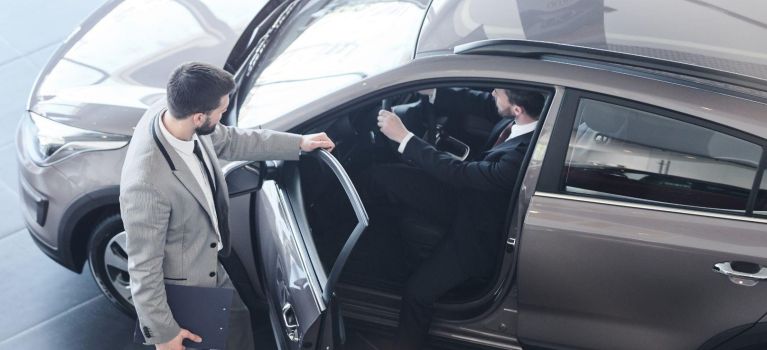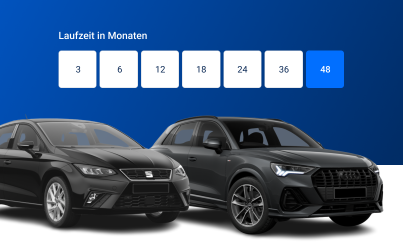- How does leasing work in Switzerland?
- What are the advantages and disadvantages of car leasing?
- How much does it cost to lease a car in Switzerland?
- What are the requirements for leasing a car in Switzerland?
- What is the difference between kilometre leasing and residual value leasing?
- What options are available at the end of the leasing contract?
- Carvolution car subscription - How does the alternative to leasing work in Switzerland?
Mobility offers such as car leasing make it possible to drive a new or a young used car without having to bear high acquisition costs. Leasing can thus be an interesting alternative to buying or financing, especially if you are not interested in committing yourself to a car for many years and want to avoid the costs of depreciation and the risk of reselling.
In this blog article, you can find out what to look out for when leasing a car in Switzerland and which alternatives might be interesting for you.
How does leasing work in Switzerland?
If you decide to lease a car, the lessor provides you with a vehicle for a defined period of time - usually between 1 and 4 years. As with the financing model, you pay a monthly amount to be allowed to drive the car, the so-called leasing instalment.
At the end of the contract term, if agreed in the contract upfront, you can decide if you want to buy the car for the remaining amount. Otherwise, you must return the leased vehicle. If you only intend to lease for a short period of time, a lease take-over may be an alternative for you. You can find all the information here.
What are the advantages and disadvantages of car leasing?
Whether the advantages or disadvantages of leasing outweigh is very individual. You certainly have lower initial costs when leasing a car compared to buying, and you don't bear any resale or residual value risk, as the vehicle must ultimately be returned to the lessor. Moreover, you can configure the specifications of your car to your liking.
However, the benefits of leasing come at a price. You have to adhere to strict kilometre and term limits and take care of insurance, taxes, tyre changes, cantonal redemption and much more yourself. For an overview of other advantages and disadvantages, click here. If you think the advantages outweigh the disadvantages, you may want to consider the costs of leasing next.
How much does it cost to lease a car in Switzerland?
How much you pay each month for a lease depends primarily on the gross list price of the car. This varies according to engine and equipment and forms the basis for the leasing instalment. The amount of the monthly instalment also depends on whether you choose a lease with or without a down payment.
However, it should be noted that the seemingly low lease instalment only covers the use of the vehicle. According to the Touring Club Switzerland (TCS), running costs can be as much as three times the leasing rate.
Running costs include repairs and maintenance, but also taxes, insurance, tyre changes and cantonal redemption. It is also important to bear in mind that maintenance and inspections must be carried out by the contractual partner.
What are the requirements for leasing a car in Switzerland?
There are a number of requirements that must be met in order to lease a car in Switzerland. In addition to permanent residence in Switzerland and a category B driving licence, non-Swiss lessees must have at least a category B or C residence permit. This is particularly important if you intend to lease as an expat in Switzerland.
A credit check is also mandatory and usually requires the submission of a payslip and an extract from the Debt Collection Register. This check ensures that the lessee is financially able to pay the instalments and protects both the lessee and the leasing company from potential risks.
You can find out more about the requirements for leasing a car in Switzerland in our detailed blog article. If you are a pensioner thinking about leasing a car but wondering whether a new lease is possible for you, you can find more information here.
What is the difference between kilometre leasing and residual value leasing?
Last but not least, the type of leasing is decisive. In Switzerland, kilometre leasing and residual value leasing are particularly popular and work as follows.
In the case of residual value leasing, the future value of the vehicle is determined at the start of the contract. The higher the residual value, the lower the monthly payments. If the vehicle's value falls more than expected, the lessee will have to pay the difference. This is why it is important to negotiate follow-up financing before the end of the contract, as the residual value is not equal to the purchase price.
On the other hand, with kilometre leasing, the instalment is based on the expected number of kilometres driven. Higher kilometres result in higher instalments. Additional costs are therefore incurred if the contract is terminated early or the agreed mileage is exceeded.
What options are available at the end of the leasing contract?
Option 1: Return your leased vehicle
As soon as the lease ends, you will normally return your vehicle to the lessor. It is not necessary to give notice of cancellation, as the contract automatically expires in the case of a term or kilometre lease. Unless otherwise agreed, the garage has an exclusive right of repurchase and will take your car back at its residual value.
Option 2: Purchase the leased vehicle at the end of the term
If it was agreed at the start of the contract that the car could be purchased, you can ask your lessor for an offer. If the lessor agrees to the purchase, you become the sole owner of the car. However, when the purchase is rejected, you must unfortunately return the car.
Option 3: Drive a new car
If you have returned your car at the end of your lease but still need a vehicle, you have several options. For example, you could ask your lessor about extending the lease on your current car, or look around for other providers and offers.
If you're still interested in a new car, but don't want to worry about running costs and find the rigid kilometre and term limits of leasing too inflexible, a car subscription could be just the right alternative for you!
Carvolution car subscription - How does the alternative to leasing work in Switzerland?
Compared to leasing, the car subscription already includes everything related to the car. This means that the monthly fixed price already includes insurance, taxes, cantonal redemption, service and new tyres.
With Carvolution, you can also choose a term of between 3 and 48 months. Once the minimum term has expired, you can continue to drive the car and do not have to return it, as is the case with car leasing. With a subscription, you can also be more flexible about the number of kilometres you drive. Instead of a fixed kilometre limit, as with a lease, you can increase or decrease the number of kilometres you drive each month.
Does that sound interesting to you? Then you can find all our Carvolution cars here. If you would like to find out more, our team is also available for a non-binding consultation.
Electric Sale
Discover a variety of electric cars at great prices and get 3'000 km for free – only for a limited time.










